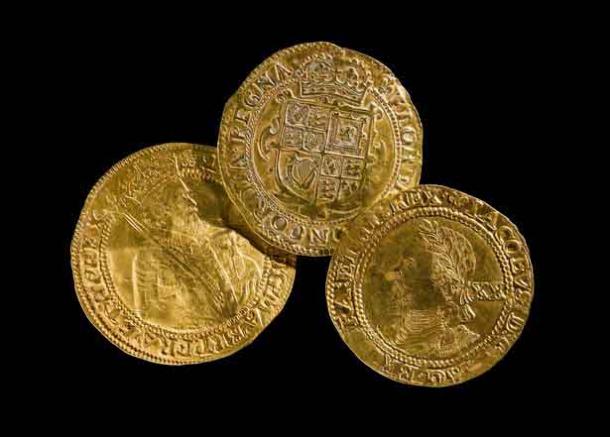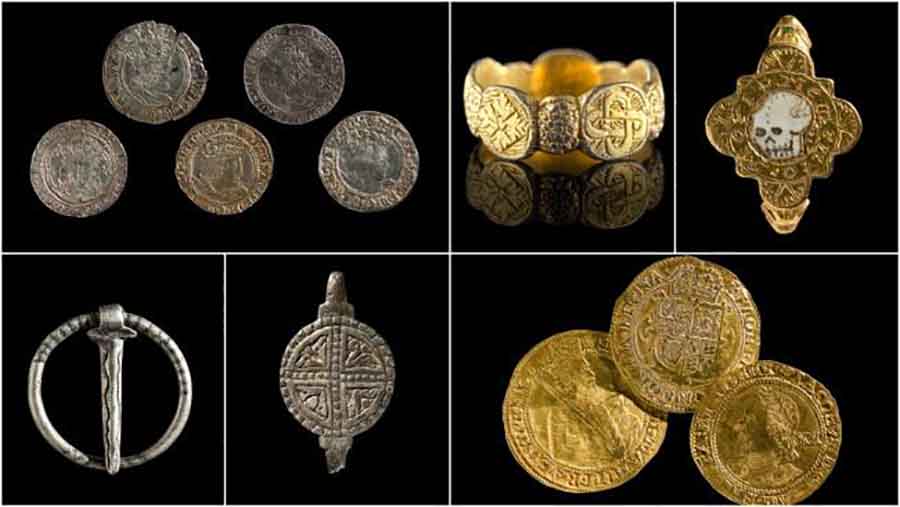Stunning Medieval Treasures Discovered in Wales By Metal Detectorists
Eight medieval and late medieval treasures have been discovered in Wales, UK, all found by metal detectorists. These treasures offer anthropologists insights into the life of wealthy members of Welsh society in the medieval period. The gold and silver medieval treasures range in origin from the 9th century to the 17th century AD.
These remarkable medieval treasures include a Memento Mori ring, a gold posy ring that resembles the fictional ring from "Lord of the Rings.”
The discovery of medieval artifacts helps archeologists and historians understand more about these cultures and their lifestyles. The items found by amateur metal detectorists include:
•Silver-gilt finger ring: Late Medieval period
•Silver bar-mount: Medieval period
•Gold posy ring: Post-Medieval period
•Gold finger ring: Post-Medieval period
•Silver annular brooch: Medieval period
•Silver Tutor coin: Tutor period
•Silver double-hooked fastener: Early Medieval period
•Gold Coin: Medieval period
Other medieval treasures have been discovered by metal detectorists all over Wales and England. In 2018, a Bronze Age ring was found by an amateur treasure hunter in Suffolk. In 2017 a silver medallion was discovered in Brecon, Wales. This medallion had a profile of Charles I with the motto of the Order of the Garter written on it: "Honi sort qui mal y pense," which translates to “Shame on him who thinks evil of it.”

17th century gold coins found by metal detectorists in the Trefeglwys Community, Powys, Wales. (National Museum Wales)
The Detectorists’ Medieval Treasures Include Rare Coins
Each of the treasures were discovered around Powys, Wales by metal detectorists. Senior curator Nigel Blackamore explained via Wales Online, "Very few gold coins have been discovered within south Powys, so we would welcome the possibility of adding these to the museum's new medieval displays.”
Three of the medieval gold coins were discovered in 2019. Historians have determined the coins were created around the 14th century. The coins were valued at 20 shillings and represented 50 days’ worth of wages for a worker during this time. It was determined that the coins were probably buried to keep them safe and were never recovered.
- Rogue Metal Detectorists Stole $3.6 Million Treasure
- British Metal Detectorists Find 3 Rare Medieval Coins Worth Thousands!
A number of 17th-century coins were also discovered. The coins were from the reigns of King James I and King Charles I, dated between 1603 and 1649 AD. Researchers again believe that these coins were buried for safekeeping. This was during the English Civil War reports the Country Times.
Four silver coins dated to Queen Elizabeth I's reign (1558-1603) were discovered in 2017. The four coins were buried together. The senior curator of Numismatics commented on the discovery of the coins in Leader Live :
“It might have been quite a significant sum to the owner of the coins. In terms of purchasing power at the time, one sixpence could have bought you three loaves of bread, or about four gallons of beer.”

A post-medieval gold finger posy ring inlaid with white enamel, found in the Carreghofa Community, Powys, Wales. (National Museum Wales)
The Memento Mori Ring and Other Posy Rings
Some of the most exciting pieces found in Powys include a gold Memento Mori ring dated between 1550 and 1650 AD. The gold ring is engraved with a skull and inlaid with white enamel. Memento Mori rings were popular during this time. The inscription on these rings, translated from the original Latin, reads: “Remember You Must Die,” a clear reminder that life is short.
- Metal Detectorists Discover Stash of 550 Ancient Coins Worth £150,000
- UK Government Redefines the Meaning of “Treasure”
Dr. Mark Redknap, Deputy Head of Collections and Research at the National Museum Wales, praised the ring found in Carreghofa according to Powys Country Times, saying, “This is a rare example of a Tudor or early Stuart memento mori ring with a clear Welsh provenance.”
Dr. Redknap and his team were thrilled when they saw the ring. Such medieval treasures help scientists understand how people in early modern Wales viewed death. This ring was created to honor the passing of a loved one.
Another posy ring discovered in Wales was a post-Medieval gold posy ring created in the late 17th or early 18th century AD. Posy rings were popular during this period.
The engraving found in the ring says: “Be Constant to the End.” Many posy rings were given as gifts between couples as a way to honor and remember a loved one. Many people viewing this ring have made connections between this ring and the fictional ring in the Lord of the Rings book series.

Late medieval silver-gilt finger ring found in the Tregynon area, Powys, Wales. (National Museum Wales)
The Y Gaer Museum and the National Museum Wales are hopeful of acquiring the entire medieval treasure collection found by metal detectorists in the area. Centre Manager Saffron Price commented on the discovery via Wales Online:
“It would be wonderful to have these coins within the museum’s collection and to put them on display for the public to enjoy.”
Top Image: Images of six of the medieval treasures found in Wales by metal detectorists in recent years. Source: Country Times
By Sarah Piraino




















Comments
The Lord of the Rings ring was like a plain gold wedding band. Just sayin..